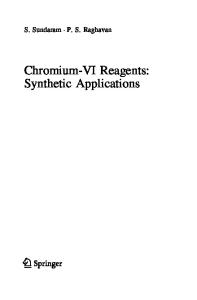Oscillatory flow reactors for synthetic chemistry applications
- PDF / 2,046,878 Bytes
- 16 Pages / 595.276 x 790.866 pts Page_size
- 58 Downloads / 297 Views
REVIEW
Oscillatory flow reactors for synthetic chemistry applications Pauline Bianchi 1 & Jason D. Williams 1,2 & C. Oliver Kappe 1,2 Received: 2 June 2020 / Accepted: 21 June 2020 # The Author(s) 2020
Abstract Oscillatory flow reactors (OFRs) superimpose an oscillatory flow to the net movement through a flow reactor. OFRs have been engineered to enable improved mixing, excellent heat- and mass transfer and good plug flow character under a broad range of operating conditions. Such features render these reactors appealing, since they are suitable for reactions that require long residence times, improved mass transfer (such as in biphasic liquid-liquid systems) or to homogeneously suspend solid particles. Various OFR configurations, offering specific features, have been developed over the past two decades, with significant progress still being made. This review outlines the principles and recent advances in OFR technology and overviews the synthetic applications of OFRs for liquid-liquid and solid-liquid biphasic systems. Keywords Oscillatory flow . Multiphasic reactions . Solid handling . Liquid-liquid reactions . Process intensification . Plug flow reactors
Introduction Continuous flow technology has attracted the attention of chemists in recent years, specifically in scaling up hazardous chemistries, photochemistry, electrochemistry and many others [1–4]. The use of various auxiliary and automation technologies has strengthened the potential of flow reactors [5–7] for a wide range of applications [8–11]. Despite the benefits of continuous flow technology, flow reactors face some inherent problems, particularly when dealing with multiphasic systems. Rational engineering has, however, begun to tackle these issues, by developing a variety of reactor configurations with specific features aimed at processing challenging reaction media on both small and large scale [12]. One particularly promising development in reactor technology is that of oscillatory flow reactors (OFRs), whereby a symmetrical oscillation is superimposed to the net flow through the reactor. This has been found to offer a solution to multiple problems encountered by conventional flow
* C. Oliver Kappe [email protected] 1
Institute of Chemistry, University of Graz, NAWI Graz, Heinrichstrasse 28, 8010 Graz, Austria
2
Center for Continuous Flow Synthesis and Processing (CC FLOW), Research Center Pharmaceutical, Engineering (RCPE), Inffeldgasse 13, 8010 Graz, Austria
reactors, whilst maintaining plug flow behavior, intense mixing, and excellent heat transfer. Importantly, oscillationpromoted mixing is independent of the net flow rate, opening the window of operation to lower flow rates (longer residence times), which would otherwise impart poor hydrodynamic properties. Another consequence of the ability to operate at low flow rates is the allowable decrease in reactor volume, enabling compact setups. In addition, the quality of mixing can be ensured during scale-up when OFR geometric ratios and fluidic characteristics are maintained [13]. A
Data Loading...











